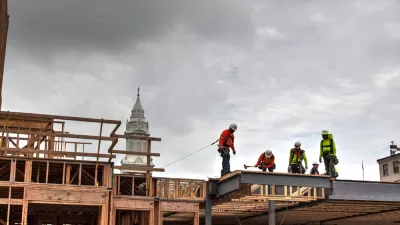A trove of data from the Office of Property Assessment has been released to the public. It's like Christmas day for zoning wonks in the City of Brotherly Love.
"The [city of Philadelphia] Office of Innovation and Technology has been upping the city's data visualization game for a while now, and the latest release of Office of Property Assessment data is everything a data dump should be," according to a post by John Geeting.
Geeting notes that the data release goes beyond a dump of raw data—there are visuals and products that helps people access the information, as well as tools to manipulate the data and mine it for more findings.
Among the findings, ready for analysis, "is that RSA-5 (the typical neighborhood rowhouse) is the most common zoning classification by far, accounting for about 42% of all properties." Other kinds of single-use zoning classifications make up the bulk of uses in the city: "Residential-only properties are 79% of the total, and hotels and apartments, stores with dwellings, and commercial properties make up just 12% of properties combined."
There are more analysis and samples of the many other interactive features available on the Office of Property Assessment site.

Trump Administration Could Effectively End Housing Voucher Program
Federal officials are eyeing major cuts to the Section 8 program that helps millions of low-income households pay rent.

Planetizen Federal Action Tracker
A weekly monitor of how Trump’s orders and actions are impacting planners and planning in America.

Ken Jennings Launches Transit Web Series
The Jeopardy champ wants you to ride public transit.

Crime Continues to Drop on Philly, San Francisco Transit Systems
SEPTA and BART both saw significant declines in violent crime in the first quarter of 2025.

How South LA Green Spaces Power Community Health and Hope
Green spaces like South L.A. Wetlands Park are helping South Los Angeles residents promote healthy lifestyles, build community, and advocate for improvements that reflect local needs in historically underserved neighborhoods.

Sacramento Plans ‘Quick-Build’ Road Safety Projects
The city wants to accelerate small-scale safety improvements that use low-cost equipment to make an impact at dangerous intersections.
Urban Design for Planners 1: Software Tools
This six-course series explores essential urban design concepts using open source software and equips planners with the tools they need to participate fully in the urban design process.
Planning for Universal Design
Learn the tools for implementing Universal Design in planning regulations.
Heyer Gruel & Associates PA
Ada County Highway District
Institute for Housing and Urban Development Studies (IHS)
City of Grandview
Harvard GSD Executive Education
Toledo-Lucas County Plan Commissions
Salt Lake City
NYU Wagner Graduate School of Public Service





























